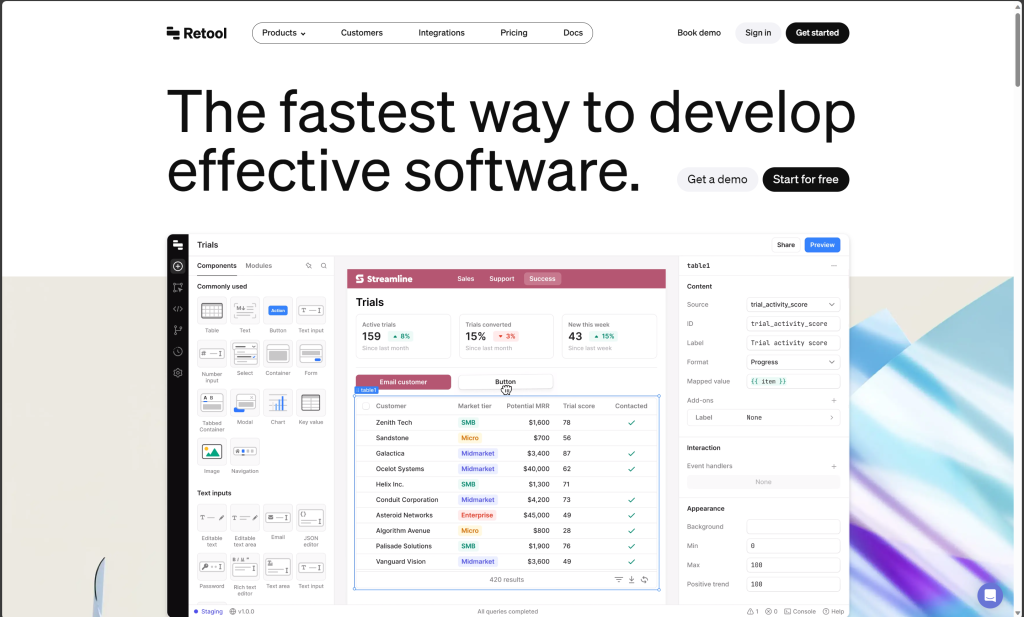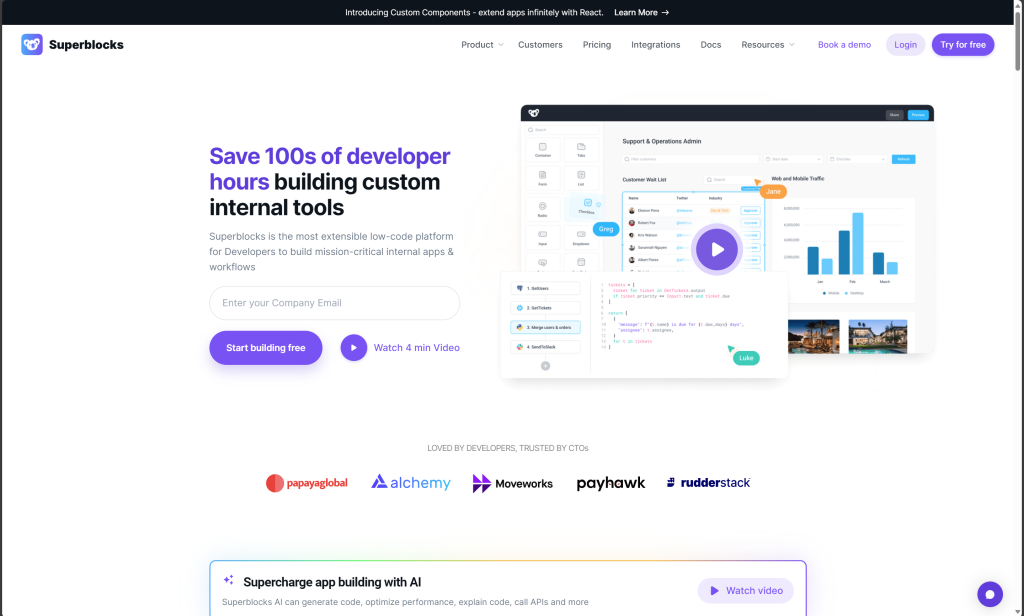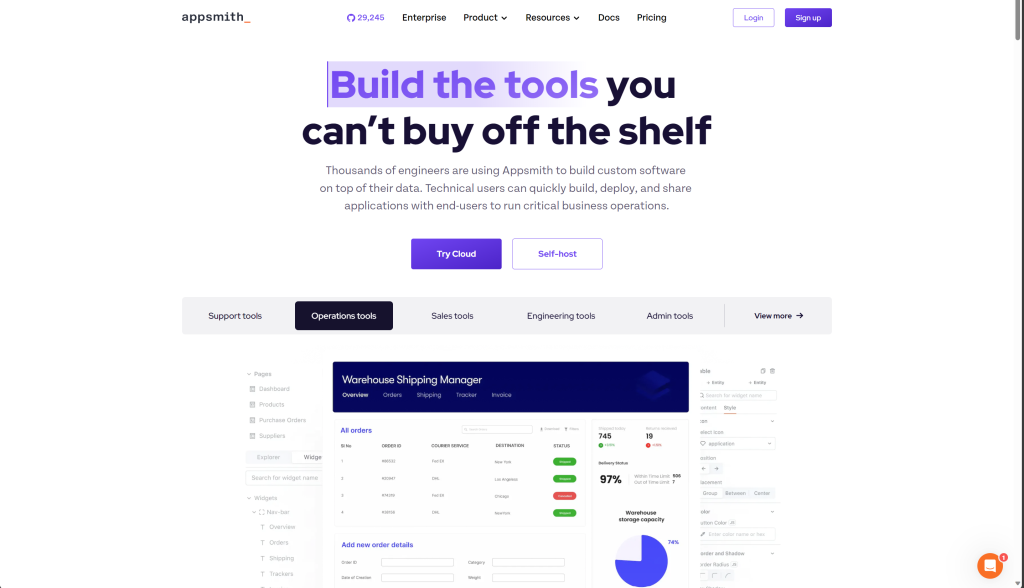Are You Still Building Internal Tools From Scratch in 2023?

What Are Internal Tools?
At some point in every programmer’s career, they will build at least one internal-facing tool also known as back-office software. Internal tools are basically software applications, systems, or digital solutions that are developed and used within an organization to facilitate specific business processes, tasks, or functions. These internal tools can range from admin panels, help desk software, CRUD apps, sales enablement software, and many more.
As these tools are designed to address the unique needs and requirements of the organization, they are considered critical business applications that can help businesses accelerate growth and be a key differentiator amongst their competitors. Multiple surveys and studies also show that almost a third of software engineering resources are spent building and maintaining these internal tools.
In today’s blog post, we are going to explore…
1) The best low-code internal tool builder
2) How to rapidly build and deploy an internal tool
3) And what it takes to build an easily maintainable internal tool
The Best Low Code Internal Tool Builder
The need for internal tools has been on the rise across different departments and organizations. To meet this demand, a growing number of low-code internal tool builders have emerged in the market. These builders offer various unique propositions that cater to different business needs.
Let’s take a closer look at some of these low-code internal tool builders and their distinctive features. By doing so, we can gain a better understanding of how these tools can help organizations streamline their processes, increase efficiency, and reduce costs.
1. Five

Five is a low-code development platform that lets software developers rapidly build and deploy bespoke business software such as internal tools. With Five you can build on top of a hosted MySQL database or connect to any data source and use SQL to query your data to create tables, charts, dashboards, and more.
You can write JavaScript and TypeScript functions to create custom business logic and further extend the capabilities of your web application beyond the pre-built components.
Five also automates front-end development. It auto-generates a responsive User Interface (UI) that works on any browser and device and gives the option to easily customize how you want your application to look in point-and-click or CSS for more advanced customizations.
Applications built with Five are deployed to scaleable, safe, and secure infrastructure with the click of a button – no cloud expertise is required. On Five’s paid subscription, developers get access to a hosted development, testing, and production environment.
Pricing: Starts from US$29.99/month per application with unlimited end users. With Five’s free download, you can develop and test your applications locally completely free of charge.
2. Retool

Retool provides a comprehensive software component library that includes tables, charts, forms, wizards, and lists. Think of Retool as a purpose-built React component library to make it easy to create a front-end for your database.
With Retool, you have access to a complete set of building blocks that allow you to focus on assembling your UI, instead of creating it from scratch. Instead of spending time searching for the best React table library, Retool allows you to build your app quickly by simply dragging and dropping.
You can easily connect to most databases using a REST, GraphQL, or gRPC API. When you run a query, Retool’s backend proxies the request, eliminating the need to worry about storing in Redux or handling errors from the backend. Retool takes care of this for you. You can read data from MongoDB, join it to Postgres with SQL, and POST the result to Stripe’s API. You only need to write the custom elements of your app, such as SQL queries, POST requests, or data transformers.
Pricing: Starts from US$10 per month and an additional US$5 per month for every end-user.
3. Superblocks

Superblocks is another low-code platform that is specifically designed for developers who are looking to build custom internal tools. It provides various tools and pre-built components that can be easily customized with visual interfaces and code. Superblocks enables developers to easily integrate with different data sources, APIs, and services, ensuring flexibility.
The platform has a strong focus on scalability and empowers teams to create applications faster than traditional coding. Superblocks is an enterprise-level tool that is designed to help organizations streamline their development process. It provides top-notch application performance, has strong audit logging, supports complex access controls, and uses a unique agent-based approach for on-premise deployments. With an easy-to-use interface and plenty of customization options, Superblocks is a great option for businesses that want to simplify their development workflow while retaining full control over their applications.
Pricing: Starts from US$49 per month and an additional US$15 per month for each non-developer user.
4. Appsmith

Appsmith is an open-source platform that enables developers to build internal applications that communicate with multiple data sources. With Appsmith, you can create applications for all of your internal use cases, such as customer support portals, sales dashboards, marketing trackers, admin panels, and easy-to-use CRUD frontends for your data.
Appsmith offers several powerful features out-of-the-box, including the ability to connect your Git hosting provider to restrict access, manage versions, and ensure compliance with processes. You can use Google and GitHub OAuth, SAML, or OIDC from all popular providers for secure authentication and authorization. And with audit logs you can see the trail of user activity, events, and changes, keeping you informed of any breaking changes and allowing you to track back to the last good state of your apps.
Pricing: Starts from US$0.40 per hour per user and caps at US$20/month per user.
How To Rapidly Build and Deploy an Internal Tool
Software development is expensive. An article from business.com states that at a base rate of $25 per hour, it will cost a business $5000 to build a minimum viable product and more than $150,000 for a complex full-scale mobile app. What this implies is that a software developer’s time is a scarce resource and the longer it takes for them to ship an internal tool the more expensive it will become.
We can all agree that measuring a developer’s productivity with lines of code is archaic and highly unreliable. There is still some truth in measuring it. The general theme of an internal-facing tool is a navigation menu, sidebar, and hamburger menu; and a developer would need to code everything from scratch every time they start building a new internal tool the traditional way using full code. This can be time-consuming and to a software developer it is an unengaging challenge.
This is where Five as a low-code development platform comes in. We built Five with software developers in mind, giving them the right toolkit to build and ship internal tools faster. Five’s main goal is to remove the boring and repetitive parts of programming using prebuilt components while still allowing you to add custom codes to build custom business logic.
Check out how you can build internal tools with your existing spreadsheet data within 12 minutes.
Get inspired by the many different use cases of Five that can be beneficial to your business.
What It Takes To Build an Easily Maintainable Internal Tool
In the world of business, building internal tools plays a big role in making things run smoothly. But just building them isn’t enough; we need to make sure they keep working well over time.
Here’s a checklist to ask yourself to get started:
- 1. Know What You Need – First, understand what the tool should do and why you’re making it. This helps you plan better and keeps the tool useful for a long time.
- 2. Choose the Right Tools – Pick the right technology to build the tool. Think about things like how easy it is to grow the tool and whether the technology is widely used.
- 3. Make It Easy to Use – A tool that’s easy to use is easier to keep working well. Design it so people can understand and use it without much trouble. Listen to what people say about the tool and make it better based on their feedback.
- 4. Build It in Pieces – Break down the tool into smaller parts that are easier to manage. This way, if something goes wrong, you can fix just that part without messing up the whole thing. Also, write the code clearly so that it’s easy to read and understand.
- 5. Test and Check – Before using the tool, test it to make sure it works the way it should. Keep checking it regularly to find and fix any problems. This makes sure the tool keeps working well and doesn’t break down unexpectedly.
- 6. Take Care of It – Decide who’s responsible for looking after the tool and how often it should be updated. Having a plan to take care of the tool ensures it keeps working well over time.
- 7. Plan for the Future – Think about how the tool might need to change as the business grows. Make sure the tool can handle more work and new features without problems.
By following these steps and always looking for ways to make the tool better, you can build internal tools that stay useful and help the business run smoothly for a long time. Below are some quotes from large organizations that build internal tools to automate their task as well as use dashboards to segregate information.
If a developer has to stop what they are doing and open a browser window for the next step in their work, then that task is a good candidate for building tooling around.
The Joy of Internal Tools (Slack)
We maintain a company dashboard that has information about product launches, company announcements, events, and internal notes from people around the company.
Internal Company Dashboard (Meta)
To conclude, you should stop building internal tools from scratch and adopt a low-code solution like Five to help you build and deploy your internal tools faster. Check out our case studies to see how others have implemented Five into their development teams with success.


